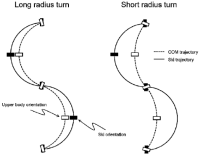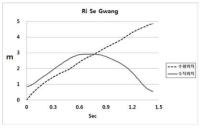
Purpose The purpose of this study was to investigate the three dimensional joint angles of the ankle, knee and hip during basic long turn, carving long turn, basic short turn and carving short turn. Methods Fourteen alpine ski instructors from Korea Ski Instructor Association participated in this study. Each skier asked to perform 4-types of turning technique, classified by radius and level. 8 inertial measurement units were used to measure three-dimensional joint angles of the ankle, knee and hip joint. Results Significant differences were found the lower extremity joint angles on the mediolateral and vertical axis during long-turn and carving-turn (p<.05). significant differences were found the lower extremity joint angles on the anteroposterior axis in the steering phases 1, 2 and complete phase (p<.05). Conclusions In the Alpine skiing, the short turn requires a complex movement of the lower limb joint compared to the long turn. When performing a long turn, the movement of the ankle joint on the vertical axis are required compared to the short turn. And the carving and short turn need to the movements of the lower limb joint on the mediolateral axis.




The aim of this study was to acquire essential information regarding Ri Se Gwang motion(element group Ⅱ, difficulty 6.4 point, double Tsukahara with tucked 1/1 twist), which Ri Se Gwang of North Korea performed during the final vault event of artistic gymnastic at Incheon Asian Game 2014, by analyzing motional characteristics. Firstly, Ri Se Gwang technique had second jump airborne time of 1.07 seconds and airborne height of 2.91m, which have great influences on the success of technique while having horizontal and vertical velocity of 2.73 m/s and 3.87 m/s, respectively, at the takeoff. These were sufficient jump motion for successful accomplishment of the technique however flight pattern was somewhat small which was mainly oriented vertically when compared to previous studies of Yeo and YANG Hak Seon 2 techniques. Secondly, blocking angle of vault contact was small at 9 degrees while having very small takeoff angle of 79 degrees. However, it had fast average trunk rotational velocity of 545 deg./s at the vault contact phase by rapidly bending trunk from the board takeoff until approaching the vault leading to achieve fast trunk rotational velocity of 452 deg./s after the take off in order to complete the airborne rotation successfully. Thirdly, the preparation phase of Ri Se Gwang technique had a distinct characteristics that the trunk was rapidly bent during the approach to the vault attempting aggressive blocking which leads to vertically oriented flight. It showed that this characteristic assists the motion of thigh snatch and the regulation of twist which strengthen airborne rotation for airborne rotational motion. And it also showed that sufficient landing and twist angles at the landing phase are possible with free rotational motion if the height of second jump reaches 3 m.








